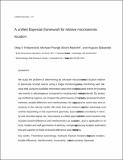| dc.contributor.author | Poliannikov, Oleg V. | |
| dc.contributor.author | Prange, Michael | |
| dc.contributor.author | Malcolm, Alison E. | |
| dc.contributor.author | Djikpesse, Hugues | |
| dc.contributor.other | Massachusetts Institute of Technology. Earth Resources Laboratory | |
| dc.date.accessioned | 2014-10-02T14:13:02Z | |
| dc.date.available | 2014-10-02T14:13:02Z | |
| dc.date.issued | 2013 | |
| dc.identifier.uri | http://hdl.handle.net/1721.1/90523 | |
| dc.description.abstract | We study the problem of determining an unknown microseismic event location relative to previously located events using a single monitoring array in a monitoring well. We show that using the available information about the previously located events for locating new events is advantageous compared to locating each event independently. By analyzing confidence regions, we compare the performance of two previously proposed location methods, double-difference and interferometry, for varying signal-to-noise ratio and uncertainty in the velocity model. We show that one method may have an advantage over another depending on the experiment geometry, assumptions about uncertainty in velocity and recorded signal, etc. We propose a unified approach to relative event location that includes double-difference and interferometry as special cases, and is applicable to velocity models and well geometries of arbitrary complexity, producing location estimators that are superior to those of double-difference and interferometry. | en_US |
| dc.description.sponsorship | ConocoPhillips (Firm) | en_US |
| dc.language.iso | en_US | en_US |
| dc.publisher | Massachusetts Institute of Technology. Earth Resources Laboratory | en_US |
| dc.relation.ispartofseries | Earth Resources Laboratory Industry Consortia Annual Report;2013-17 | |
| dc.subject | Microseismic | |
| dc.subject | Inversion | |
| dc.subject | Fractures | |
| dc.title | A unified Bayesian framework for relative microseismic location | en_US |
| dc.type | Technical Report | en_US |
